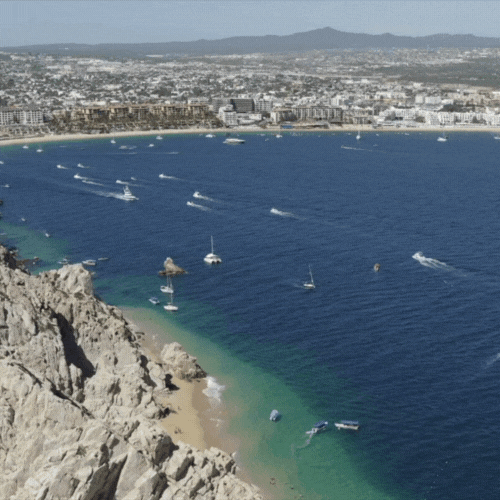Cabo San Lucas
WHERE THE LAND ENDS
A brief history of Cabo San Lucas 🐚🌞

Named after Saint Luke, Cabo San Lucas served as a supply point for Pacific-bound Spanish ships in the 16th century. For centuries, it remained a sleepy fishing village — until the 20th century 🚧.
With the 1970s construction of the Transpeninsular Highway, Cabo hit the accelerator. Resorts rose, developers arrived, and tourism took off like a marlin on the line 🎣.
Today, Cabo San Lucas is not only a celebrity magnet 🌟 but a global destination known for its nightlife 🍸, fishing tournaments, and jaw-dropping natural beauty 🌅.
The Medano Beach
🌴 Welcome to Medano Beach: Cabo’s Beating Heart
Located at the southern tip of the Baja Peninsula, Medano Beach is where Cabo comes to life 🕶️🍹. Stretching 2 miles of soft white sand and crystal-clear waters, it’s the place where relaxation meets adrenaline — and where every sunset is Instagram-worthy 📸🌅.
🎯 What to Do at Medano Beach
-
Swim & Soak ☀️: It’s one of Cabo’s safest beaches for swimming, with calm waters and perfect tanning spots. Just check the local flags — Mother Nature can be moody sometimes.
-
Thrill in the Waves 🌊: Jet skis, paddleboards, parasailing? Yes, yes, and YES. Rentals are everywhere, so no excuses!
-
Dine Like a Rockstar 🍤🍸: Beach clubs, oceanfront bars, and live music fill the shoreline. Whether you want ceviche or cocktails, this is the place to vibe with your toes in the sand.
The marina in Cabo San Lucas is a popular destination for boating enthusiasts and tourists alike. The marina is home to a wide variety of boats, including luxury yachts, fishing boats, and water taxis. Visitors can charter a boat for a day trip, go sport fishing, or take a sunset cruise around the bay.
The marina is also home to several restaurants and bars, as well as shops and boutiques selling souvenirs and local crafts. The marina is also a starting point for many water activities like Jet Skiing, Parasailing, and more. It's also a great place to take a stroll and enjoy the beautiful views of the surrounding area and the Sea of Cortez.

Amelia Wilkes Plaza
In the heart of Cabo San Lucas, where the desert meets the sea, lies a vibrant gathering place known as Amelia Wilkes Plaza. This plaza is not just a public space; it is a living testament to the rich culture and community spirit of the area, filled with stories of connection and joy.
Amelia Wilkes Plaza was named after a beloved local figure, Amelia Wilkes, a pioneer who dedicated her life to the community. Amelia was known for her unwavering commitment to improving the lives of those around her, from organizing local festivals to supporting artisans and small businesses. Her vision was to create a central space where people could come together to celebrate their culture, share their stories, and enjoy the beauty of Cabo.
Amelia Wilkes Plaza on Friday & Sunday
Every Friday local artists meet at Plaza Amelia Wilkes where La Plaza del Arte takes place.
Painters, Sculptors, plastic artists exhibit their pieces of art accompanied by a selection of local artists, dancers and acrobats taking the square to delight those present with a dose of entertainment and good time 100% family do not miss. start 7:00 pm

A Glimpse into Cabo San Lucas History 🐚🌅
Long before luxury resorts and A-list visitors, Cabo San Lucas was home to the Pericú people, a resilient and skilled indigenous community. They lived in coastal villages, spoke their own language, followed deep-rooted traditions, and relied on the sea for survival 🌊🎣.
👣 Led by wise chiefs and shamans, the Pericú thrived until the Spanish arrived in the 16th century. Sadly, colonization brought forced labor, disease, and brutal treatment — leading to a tragic decline in their population.
Today, while the Pericú people are considered extinct as a distinct group, their legacy lives on through their descendants, ancient rock art 🪨, and the cultural footprints they left across Baja California.
🚢 Cabo San Lucas was named by Spanish explorers as a tribute to Saint Luke, the patron saint of sailors ⛵. In the 1800s, it was just a tiny fishing village known for pearl diving and salt production.
Everything changed in the 20th century with the arrival of the Transpeninsular Highway and world-class resorts 🌴. Cabo evolved from a sleepy town to a global hotspot, beloved for its stunning beaches, sportfishing, and vibrant nightlife ✨🎉.
From ancient heritage to modern paradise — Cabo San Lucas is a destination with soul, history, and unforgettable vibes 🧭💃🌊.
🌴 Welcome to Medano Beach: Cabo’s Beating Heart
Located at the southern tip of the Baja Peninsula, Medano Beach is where Cabo comes to life 🕶️🍹. Stretching 2 miles of soft white sand and crystal-clear waters, it’s the place where relaxation meets adrenaline — and where every sunset is Instagram-worthy 📸🌅.
🎯 What to Do at Medano Beach
-
Swim & Soak ☀️: It’s one of Cabo’s safest beaches for swimming, with calm waters and perfect tanning spots. Just check the local flags — Mother Nature can be moody sometimes.
-
Thrill in the Waves 🌊: Jet skis, paddleboards, and parasailing? Yes, yes, and YES. Rentals are everywhere, so no excuses!
-
Dine Like a Rockstar 🍤🍸: Beach clubs, oceanfront bars, and live music fill the shoreline. Whether you want ceviche or cocktails, this is the place to vibe with your toes in the sand.
Amazing destination located in Baja California Sur, Mexico. Visitors can enjoy a variety of outdoor activities such as whale watching, snorkeling, and hiking. The city also boasts a vibrant nightlife with plenty of bars and restaurants to explore.









